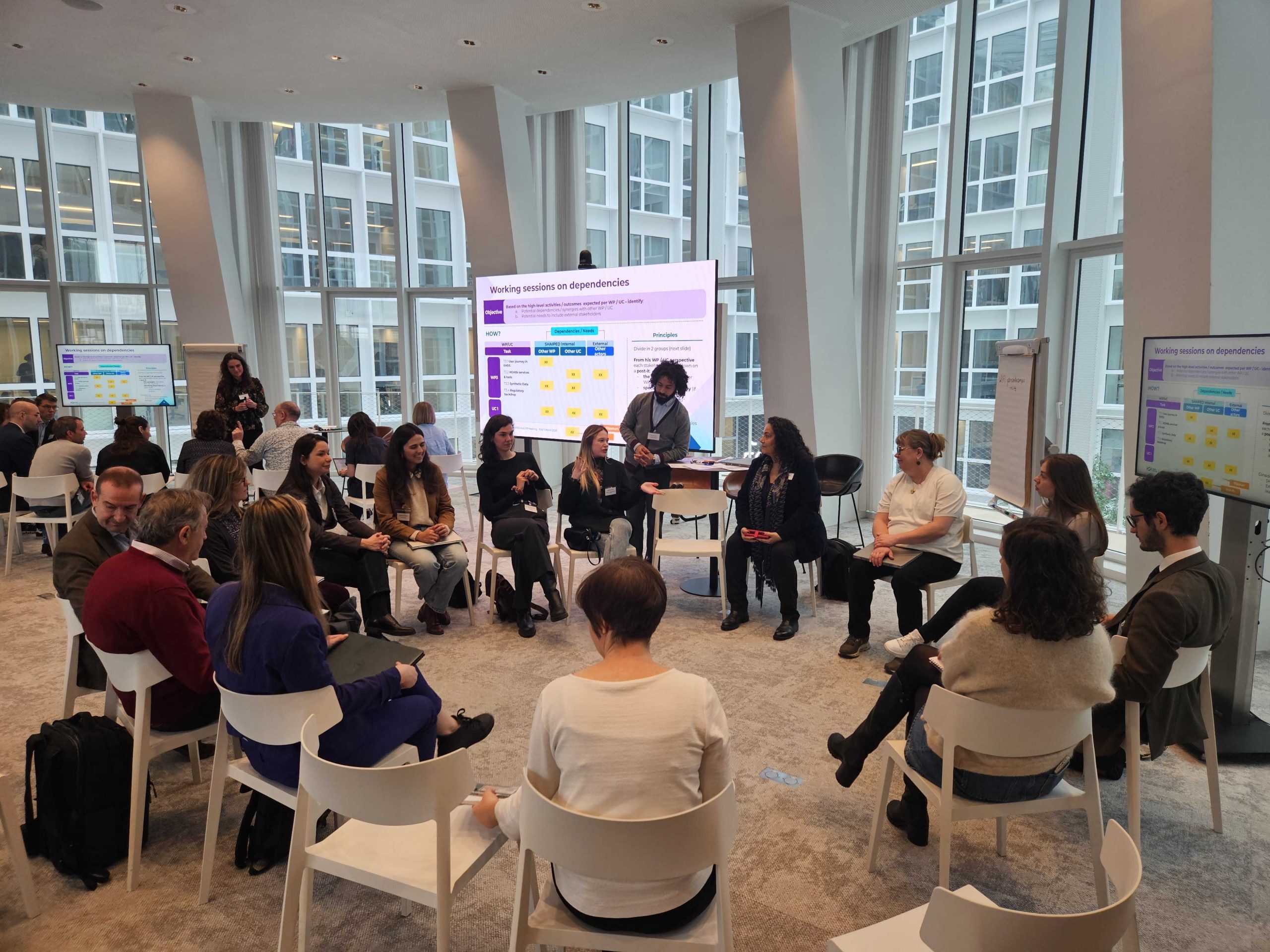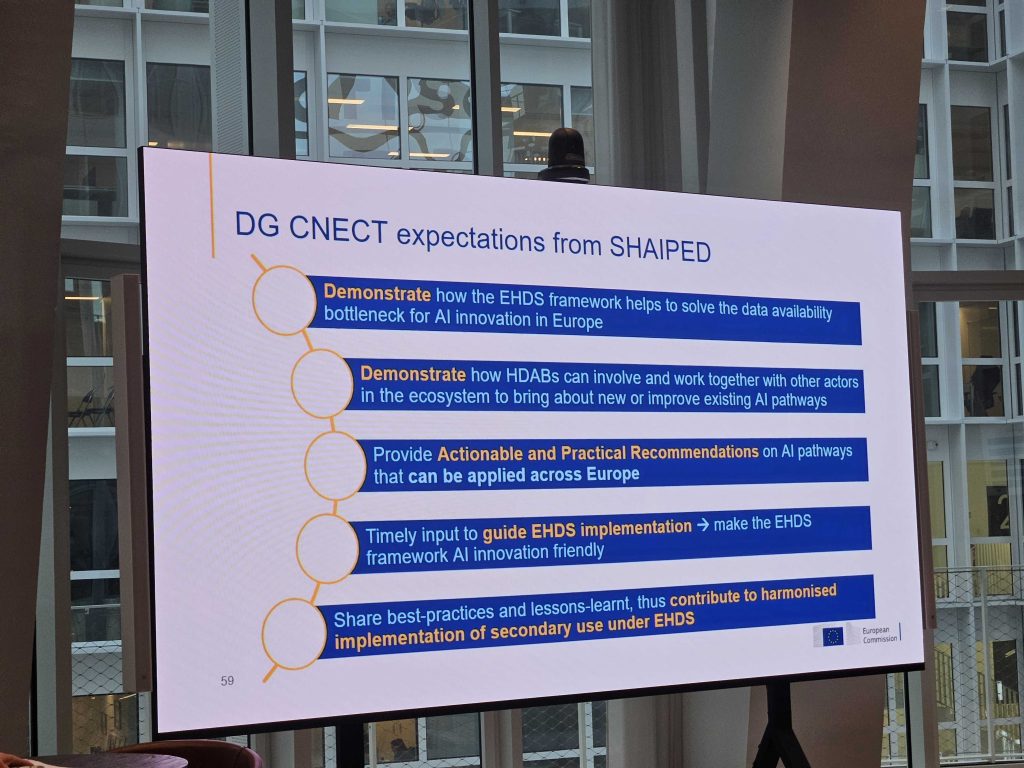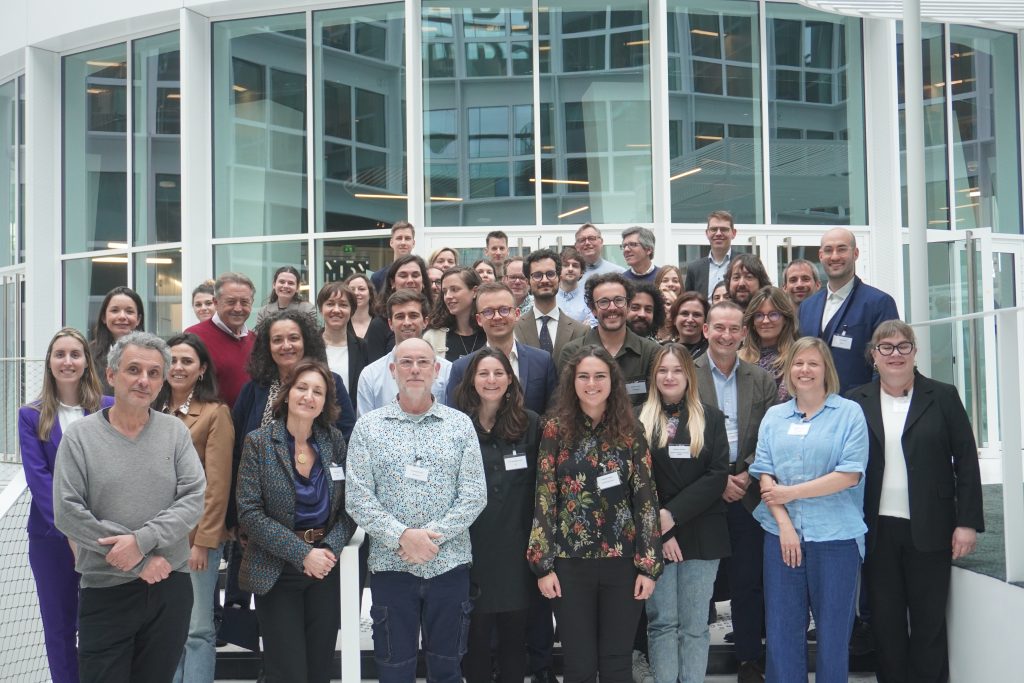Supporting Health Data Access Bodies to establish AI pathways enabling Deployment of AI as medical device tools (SHAIPED) officially launched with a successful two-day kick-off meeting held at PariSanté Campus in Paris on 10 and 11 March 2025.
The event brought together key stakeholders, project partners, and leading experts from across Europe to align on SHAIPED’s strategic goals and establish a strong foundation for future activities. SHAIPED is a non-profit public-private consortium of experts in field of healthcare and artificial intelligence (AI) focused on enhancing the development, testing, and deployment of AI-based medical devices (AIaMD) within the framework of the European Health Data Space (EHDS). The consortium brings together 30 partners coordinated by the Health Data Hub (HDH) and is funded under the Digital Europe Program with almost 4 million euros for a period of three years.
Over the next three years, SHAIPED will bring the EHDS ecosystem closer to the AI medical device innovation and regulatory ecosystems. SHAIPED consortium aims to address key challenges in AI-based healthcare by defining structured pathways for AI model development and market access. Furthermore it will support the synergistic implementation of the EHDS regulation and the Artificial Intelligence Act (AI Act), strengthen the EHDS ecosystem and support capacity building at the health data access bodies (HDAB) level. The project will leverage synergies with existing European initiatives such as EUCAIM and TEF-Health, while ensuring compliance with the evolving regulatory landscape, including the AI Act, Medical Devices Regulation (MDR) and Health Technology Assessment (HTA) Regulation.
Day 1 AM – Monday 10 March 2025 – Working sessions
The SHAIPED Project kick-off meeting began with a productive morning working session that brought together key stakeholders from Work Packages (WPs), Tasks and Use Cases (UCs). The primary objectives were to gather these crucial team members, revisit the project’s main activities and expected outputs, and collaboratively explore the dependencies and synergies within SHAIPED’s internal structure and with external actors. To facilitate focused discussions, participants were divided into two groups. The first group concentrated on WP3 and UC1, while the second group addressed WP4 and UC2 and UC3. This strategic division allowed for in-depth exploration of specific project components and their interconnections.
The working sessions yielded valuable insights into the dependencies and needs of each WP and UC. Participants identified critical areas for collaboration, potential challenges, and opportunities for synergy both within the project and with external stakeholders. These discussions laid a strong foundation for the project’s future activities, highlighting the importance of cross-functional cooperation and strategic partnerships to achieve SHAIPED’s ambitious goals in advancing AI-based medical device ecosystem within the European healthcare landscape.

Day 1 PM – Monday 10 March 2025 – Official launch
The official launch was led by Emmanuel Bacry, Chief Scientific Officer at HDH. In his opening remarks, Bacry emphasized the strategic importance of SHAIPED as the second major EU-funded project coordinated by HDH after HealthData@EUPilot. He outlined four key objectives for SHAIPED: establishing a clear overview of the project’s deliverables, strengthening collaboration between partners, ensuring alignment on key activities and timelines, and building a dynamic working environment for innovation and problem-solving.
Following the official launch Luis Martí-Bonmatí, Director of the Clinical Area of Medical Imaging Department at University Hospital La Fe and Scientific Coordinator of EUCAIM project, and Ignacio Blanquer, Professor at Universitat Politècnica de València, presented an overview of the EUCAIM project, which serves as a federated infrastructure for cancer imaging data across Europe. This initiative aims to make research cancer imaging data from various EU-level and national sources accessible and usable, supporting the development of AI-driven solutions for precision medicine.
EUCAIM’s alignment with EHDS and its involvement in the SHAIPED project were highlighted during the presentation. The speakers detailed the EHDS data user journey for accessing the EUCAIM Atlas of Cancer Images. Furthermore, EUCAIM’s potential contributions to SHAIPED, particularly in the oncology use case, were outlined. These include offering hosted data, processing capabilities, a catalogue of tools, and implementation methodologies, all of which could significantly enhance SHAIPED’s objectives in developing AI solutions for medical devices. This collaboration underscores EUCAIM’s pivotal role in advancing European healthcare through innovative data sharing and AI technologies.
Line Farah, pharmacist and Project Director at la DNS (French eHealth delegation at the Ministry of Health and Prevention) presented France’s National Strategy for AI in healthcare. Farah outlined the challenges facing AI-based medical devices in terms of evaluation, market access, and regulatory compliance. Improved scientific standards and regulatory frameworks are needed to build trust in AI models. Farah concluded by emphasizing the ongoing challenges in establishing trustworthy AI in healthcare and suggested that SHAIPED could play a crucial role in supporting this process.
EU Strategy for AI in Healthcare: Insights from European Commission and HaDEA Leaders
Aleksandra Wesolowska, Programme Officer from European Commission, outlined the EU’s strategic ambition for AI leadership, emphasizing continuous investments in key technologies and initiatives to foster an innovative European AI ecosystem. Wesolowska also presented relevant DIGITAL Europe programmes, including AI factories for healthcare, the TEF-Health programme, and the European Digital Innovation Hubs (EDIHs) network, which will play crucial roles in SHAIPED’s activities and the sustainable development of AI-based medical devices within the European Health Data Space (EHDS).
Irini Kessissoglou, PhD, Policy Officer from European Commission, focused on the EHDS and its cross-border secondary use infrastructure, HealthData@EU. She explained the user journey for AI model innovators within the EHDS and emphasized the role of authorized participants like European Digital Infrastructure Consortiums (EDICs) in SHAIPED. Kessissoglou highlighted DG SANTE’s high expectations for the project, particularly regarding the capacity of Health Data Access Bodies (HDABs) to extract AI models from Secure Processing Environments while maintaining GDPR compliance, the use of the EHDS framework, and lessons learned on federated analysis and EU data.
Both speakers underscored the importance of SHAIPED in advancing AI in healthcare within the European regulatory landscape and its potential to contribute significantly to the EU’s AI leadership goals.
European Health and Digital Executive Agency (HaDEA), created in 2021, implements European programmes and initiatives within the health, food safety, digital, industry and space sectors. Maria Saarela, Project Officer from HaDEA, outlined SHAIPED-specific objectives, Grant Agreement details, roles and responsibilities, and key processes including reporting and financial management.

WP5 Use Cases were presented at the Kickoff
Pauline Cohen, European Project Manager at Health Data Hub, provided an overview of SHAIPED, including its EU context, consortium composition, project approach, main deliverables, structure, and high-level timelines. Youness Khalil, AI Project Manager at Health Data Hub, opened the deep-dive session on WP5, presenting three key use cases that leverage AI to address distinct healthcare challenges. Experts from various institutions led the discussions, outlining objectives, timelines, risks, and mitigation strategies. Each presentation was followed by a Q&A session, addressing regulatory and technical considerations
The Chronic Kidney Disease (CKD) use case was presented by Philip Munch and Christian Fynbo Christiansen from Aarhus University, focusing on AI-based prediction models for CKD. A key topic of discussion was the EU common data access form, introduced under TEHDAS II. DG SANTE emphasized the importance of adopting the EU common data permit application form, but some countries’ representatives clarified that, since the EHDS regulation is not yet in effect, they must use their national data access forms, with the EU form serving only for comparative testing.
DG SANTE highlighted SHAIPED as an opportunity to test synthetic data as a workaround for potential data access delays, but use case leaders cautioned that regulatory challenges remain, as EHDS is focused on real health data, not synthetic substitutes. The challenge of extracting the model from the SPE was also discussed, with an agreement to focus on learnings rather than complexity. Additionally, there was a discussion about the feasibility of a horizontal data model across use cases, but it was concluded that the differences in scope make this unlikely.
The second use case, focused on oncology, was originally set to be presented by Alizée Diatchenko but was instead led by Anaïs Arliaud from Centre Léon Bérard. This use case aims to support healthcare organizations in evaluating AI models, with a particular focus on AIaMD. Arliaud emphasized potential synergies with EUCAIM, which could provide data hosting and software benchmarking, although funding limitations remain a challenge. The evaluation process will primarily assess already approved AI models using a standardized methodology and validation cohorts. The EUCAIM Scientific Director highlighted that the models will initially be tested across four national datasets, with the possibility of expanding to additional EUCAIM data holders in the future. Additionally, discussions addressed how EUCAIM services, such as data hosting and pipeline implementation, could be leveraged to enhance the use case, though a preliminary state-of-the-art assessment will be conducted to map potential collaborations.
Presented by Camille Dorra, Corporate Development Manager from Implicity, cardiology use case aims to explore AI models’ role in market access and reimbursement pathways. She explained that the use case was originally designed to test support for innovators navigating reimbursement processes, but it will now also provide insights for WP4 tasks, particularly around post-market surveillance Currently, the linkage between German data and Implicity still presents a challenge as HDLs are not yet operational, with no timeline for when data linkage services will be available. DG SANTE emphasized the importance of developing these services within the EHDS framework, noting that the SHAIPED project presents an opportunity for HDABs, including German bodies, to enhance their data preparation services. Additionally, DG SANTE discussed the potential use of synthetic data as a workaround if real-world data is unavailable, although the Nico Ridel pointed out that synthetic data still requires real data for generation, meaning delays may persist.
The session emphasized the challenges of regulatory compliance, data access, and AI integration while showcasing the progress made in leveraging AI for healthcare under SHAIPED. It highlighted the potential for improving healthcare outcomes through collaboration and innovation. The day ended with a networking session, allowing participants to strengthen professional relationships and encourage cross-functional collaboration.
Day 2 – Tuesday 11 March 2025
The second day of the kick-off meeting featured insightful presentations, providing a deep dive into ongoing EU projects and the pathways for AI development and deployment in healthcare.

The day opened with a speech by Mario Jendrossek, European Project Lead from Health Data Hub, who set the stage for the day’s discussions and emphasized the importance of a shared vision moving forward.
Petra Ritter, Neuroscientist at Charité University Medicine Berlin, provided an overview of the EU AI Act and its implications for medical devices with AI systems. She discussed how the AI Act classifies these devices as “high risk” and outlined the upcoming compliance deadlines. Petra also introduced the TEF-Health initiative, which will support AI implementation in line with the AI Act. The session included a Q&A session where Petra clarified that TEF-Health is not only cataloging existing services but also developing new services to adapt to the evolving regulations.
Following this, Enrique Bernal-Delgado, Senior Scientist at Aragon Institute for Health Sciences, presented the QUANTUM project, which focuses on creating data quality and utility labels for HealthData@EU. The project aims to ensure that all data collected with public funds meets specific quality and utility standards. Enrique highlighted the project’s ongoing phases and the development of a self-assessment tool for data quality labeling.
Next, the EUCAIM Software Marketplace, which offers tools for data preprocessing and AI model evaluation, was presented by Leonor Cerdá Alberich, Head of the Computing and AI Department at IIS La Fe. Leonor explained the software registration and validation process and stressed the importance of benchmarking tools for AI models based on fairness, quality, and clinical outcomes. She also proposed offering EUCAIM’s infrastructure and services to support AI model testing in SHAIPED’s UC2.
Identification of pathways for supporting AI development and testing
The afternoon session focused on Pathways for AI Development & Testing, where Pascal Derycke, WP3 Lead, and other task leads presented the objectives and timelines of the work package. Key topics included the role of HDABs in supporting synthetic data creation and the integration of synthetic data within use cases. The discussion also covered aligning WP3 with other work packages and assessing how synthetic data could expedite the process of data accessibility.
Elaboration of pathways for AI medical device deployment
The day concluded with a deep dive into WP4, which addresses the pathways for AI deployment. Persephone Doupi from the Finnish Institute for Health and Welfare led the discussion together with Silvia Moler-Zapata from the Aragon Institute for Health Sciences. They presented objectives, timelines, expected deliverables, and the dependencies between other work packages, use cases, and external actors.
During the Q&A, it was highlighted that the new EU HTA Regulation would harmonize HTA procedures across the EU. The external market benchmarking discussion emphasized the need to examine practices in countries like Korea, where processes for AI models are already in place. One of the key challenges was identified as the rapidly evolving nature of AI models, which requires agile and flexible certification and evaluation processes to keep pace with these advancements.
The day ended with closing remarks from Mario Jendrossek, who reflected on the significance of the kick-off meeting in aligning the project’s goals and fostering collaboration.
Key Takeaways and Future Steps
The SHAIPED kick-off meeting successfully established a clear strategic direction for the project and outlined concrete action points for the next phases. One of the key takeaways was the importance of collaboration between work package leads and use case partners to ensure alignment and avoid duplication of efforts. Early engagement with regulatory bodies will be essential to navigate the complex certification requirements for AI-based medical devices.
SHAIPED’s next general assembly meeting is scheduled for June 2025, where progress on work packages and use cases will be reviewed. All partners were encouraged to maintain open communication and actively contribute to SHAIPED’s shared goals.
SHAIPED represents a significant step forward in the development and deployment of AI-based medical devices in Europe. With strong support from the European Commission and alignment with EU regulations, SHAIPED is poised to drive innovation and improve healthcare outcomes across Europe.